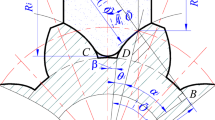Abstract
The cutting fluid has a great influence on the thermal behavior of machine tools using flood cooling technique. But majority of machine tools thermal models are without considering the cutting fluid absorbing grinding heat and its effect on the thermal behavior. In this paper, a thermal-structure coupling finite element model considering the cutting fluid thermal influence was developed and a special measurement system was established, and a series of load experiments were carried out to validate this model. The simulation results and experimental data are in good agreement. The thermal behavior of the machine tool has been estimated using the proposed thermal models. The effect of coolant and machining position on thermal deformation was also analyzed. The results show that larger temperature gradient occurred in the X- and Z-directions of the whole machine because cutting fluid absorbing grinding heat and lead to ambient temperature rise of machine tool enclosed housing. The combined effect of the X- and Z-direction thermal deformation causes the column and the workpiece column obviously appear “backwards” distortion. The coolant channels of bed can be designed to be symmetrically distributed around the motorized spindle in the X-direction to further reduce the thermal deformation.
Similar content being viewed by others
References
Mayr J, Jedrzejewski J, Uhlmann E et al (2012) Thermal issues in machine tools. CIRP Ann Manuf Technol 61:771–791
Ma C, Yang J, Zhao L et al (2015) Simulation and experimental study on the thermally induced deformations of high-speed spindle system. Appl Therm Eng 86:251–268
Xiaojun S, Yueran K, Lijun F et al (2017) Thermo-structural coupling calculation method for permanent magnetic synchronous motorized spindle. J Huazhong Univ Sci Techno 45:50–54
Yueran K, Xiaojun S, Jianmin G et al (2016) Modeling and analyzing multi-variable coupling thermal characteristics for motorized spindle. J Xi’an Jiaotong Univ 50:32–37
Yueran K, Xiaojun S, Jianmin G et al (2017) Thermal behavior analysis of a motorized spindle with shaft core cooling. J Xi’an Jiaotong Univ 51:13–18
Zhao HT, Yang JG, Shen JH (2007) Simulation of thermal behavior of a CNC machine tool spindle. Int J Mach Tools Manuf 47(6):1003–1010
Cui LY, Zhang DW, Gao WG, Qi XY, Shen Y (2011) Thermal errors simulation and modeling of motorized spindle. Adv Mater Res 154–155:1305–1309
Brecher C, Wissmann A (2009) Stressing unit for modelling of thermal behaviour of a milling machine. 12th CIRP conference on Modelling of Machining Operations, Donostia - San Sabastian – Spain
Chen JS (1996) A study of thermally induced machine tool errors in real cutting conditions. Int J Mach Tools Manuf 36(12):1401–1411
Gleich S (2007) Approach for simulating ball bearing screws in thermal finite element simulation. J Mac Eng 7(1):101–107
Horejs O et al (2007) Determination of positioning error of feed axes due to thermal expansion by infrared thermography, ATEM’07, JSME-MMD, pp 12–14
Zah MF, Maier T (2010) Thermal simulation of machine tools. Zeitschrift fur Wirtschaftlichen Fabrikbetrieb 105(7–8):655–659
Gomez-Acedo E, Olarra A, de la Calle LN (2012) A method for thermal characterization and modeling of large gantry-type machine tools. Int J Adv Manuf Technol 62(9–12):875–886
Zhang J, Feng P, Chen C et al (2013) A method for thermal performance modeling and simulation of machine tools. Int J Adv Manuf Technol 68:1517–1527
Tan B, Mao X, Liu H et al (2014) A thermal error model for large machine tools that considers environmental thermal hysteresis effects. Int J Mach Tool Manu 82-83:11–20
Turek P et al (2010) Methods of machine tool error compensation. J Mac Eng 10(4):5–26
Neugebauer R et al (2010) An extended procedure for convective boundary conditions on transient thermal simulations of machine tools. Prod Eng Res Deve 6:641–646
Anton S, Andreas S, Friedrich B (2015) Heat dissipation in turning operations by means of internal cooling. Process Eng 100:1116–1123
Mayr J, Gebhardt M, Benjamin Be a (2014) Cutting fluid influence on thermal behavior of 5-axis machine tools. Procedia CIRP 14:395–400
Dai S (1993) Rolling bearing application handbook of machine tool. China Machine Press, Beijing
Butron RA, Staph HE (1967) Thermally activated seizure of angular contact bearing. ASLE Trans 10(4):408–417
Chen C (2011) Study on analysis and optimization for thermal performance of vertical machining center. Tsinghua University, Beijing
Malkin S (1989) Grinding technology theory an application of machining with abrasives. Eillish Horwood Limited, England
Z. P, Lu Y (1995) Heat transfer theory. Higher education press, Beijing
Yang S, Tao W (2006) Heat transfer, 4th edn. Higher Education Press, Beijing
Otakar H (2007) Thermo-mechanical model of ball screw with non-steady heat sources. Thermal Issues in Engineering Technology 1:133–137.(4)
Lee J, Kim DH, Lee CM (2015) A study on the thermal characteristics and experiments of high-speed spindle for machine tools. Int J Precis Eng Manuf 16(2):293–299
Harris TA, Kotzalas MN (2010) Essential concepts of bearing technology. China Machine Press, Beijing
Holkup T, Cao H, Kolar P et al (2010) Thermo-mechanical model of spindles. CIRP Ann 59(1):365–368
Funding
This study received financial support from the National Machine Tool Key Projects of China [Grant Number 2014ZX04001191].
Author information
Authors and Affiliations
Corresponding author
Rights and permissions
About this article
Cite this article
Shi, X., Zhu, K., Wang, W. et al. A thermal characteristic analytic model considering cutting fluid thermal effect for gear grinding machine under load. Int J Adv Manuf Technol 99, 1755–1769 (2018). https://doi.org/10.1007/s00170-018-2562-0
Received:
Accepted:
Published:
Issue Date:
DOI: https://doi.org/10.1007/s00170-018-2562-0



